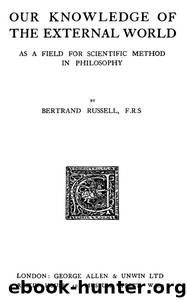Our Knowledge of the External World as a Field for Scientific Method in Philosophy by Bertrand Russell

Author:Bertrand Russell [Russell, Bertrand]
Language: eng
Format: epub, mobi
Tags: Knowledge, Theory of, Logical atomism
Published: 2011-08-15T04:00:00+00:00
Philosophers, mostly in ignorance of the mathematician's analysis, have adopted other and more heroic methods of dealing with the primâ facie difficulties of continuous motion. A typical and recent example of philosophic theories of motion is afforded by Bergson, whose views on this subject I have examined elsewhere.[20]
Apart from definite arguments, there are certain feelings, rather than reasons, which stand in the way of an acceptance of the mathematical account of motion. To begin with, if a body is moving at all fast, we see its motion just as we see its colour. A slow motion, like that of the hour-hand of a watch, is only known in the way which mathematics would lead us to expect, namely by observing a change of position after a lapse of time; but, when we observe the motion of the second-hand, we do not merely see first one position and then another—we see something as directly sensible as colour. What is this something that we see, and that we call visible motion? Whatever it is, it is not the successive occupation of successive positions: something beyond the mathematical theory of motion is required to account for it. Opponents of the mathematical theory emphasise this fact. “Your theory,” they say, “may be very logical, and might apply admirably to some other world; but in this actual world, actual motions are quite different from what your theory would declare them to be, and require, therefore, some different philosophy from yours for their adequate explanation.”
The objection thus raised is one which I have no wish to underrate, but I believe it can be fully answered without departing from the methods and the outlook which have led to the mathematical theory of motion. Let us, however, first try to state the objection more fully.
If the mathematical theory is adequate, nothing happens when a body moves except that it is in different places at different times. But in this sense the hour-hand and the second-hand are equally in motion, yet in the second-hand there is something perceptible to our senses which is absent in the hour-hand. We can see, at each moment, that the second-hand is moving, which is different from seeing it first in one place and then in another. This seems to involve our seeing it simultaneously in a number of places, although it must also involve our seeing that it is in some of these places earlier than in others. If, for example, I move my hand quickly from left to right, you seem to see the whole movement at once, in spite of the fact that you know it begins at the left and ends at the right. It is this kind of consideration, I think, which leads Bergson and many others to regard a movement as really one indivisible whole, not the series of separate states imagined by the mathematician.
To this objection there are three supplementary answers, physiological, psychological, and logical. We will consider them successively.
(1) The physiological answer merely shows that, if
Download
Our Knowledge of the External World as a Field for Scientific Method in Philosophy by Bertrand Russell.mobi
This site does not store any files on its server. We only index and link to content provided by other sites. Please contact the content providers to delete copyright contents if any and email us, we'll remove relevant links or contents immediately.
| Anthropology | Archaeology |
| Philosophy | Politics & Government |
| Social Sciences | Sociology |
| Women's Studies |
The remains of the day by Kazuo Ishiguro(8761)
Tools of Titans by Timothy Ferriss(8163)
Giovanni's Room by James Baldwin(7124)
The Black Swan by Nassim Nicholas Taleb(6955)
Inner Engineering: A Yogi's Guide to Joy by Sadhguru(6641)
The Way of Zen by Alan W. Watts(6460)
Asking the Right Questions: A Guide to Critical Thinking by M. Neil Browne & Stuart M. Keeley(5584)
The Power of Now: A Guide to Spiritual Enlightenment by Eckhart Tolle(5554)
The Six Wives Of Henry VIII (WOMEN IN HISTORY) by Fraser Antonia(5365)
Astrophysics for People in a Hurry by Neil DeGrasse Tyson(5101)
Housekeeping by Marilynne Robinson(4260)
12 Rules for Life by Jordan B. Peterson(4227)
Double Down (Diary of a Wimpy Kid Book 11) by Jeff Kinney(4153)
The Ethical Slut by Janet W. Hardy(4153)
Skin in the Game by Nassim Nicholas Taleb(4128)
Ikigai by Héctor García & Francesc Miralles(4052)
The Art of Happiness by The Dalai Lama(4015)
Skin in the Game: Hidden Asymmetries in Daily Life by Nassim Nicholas Taleb(3873)
Walking by Henry David Thoreau(3864)
